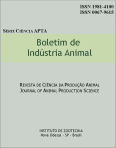Analysis of growth curve in Santa Ines females sheep
Keywords:
non-linear regression, weightAbstract
In a sheep production system, the growth-related characteristics have direct relationship to both, quantity and quality of meat. The objective of this study was to evaluate the application of non-linear models to report the growth curve of Santa Inês sheep. Weights of 140 females, born from2010 to 2012, from a single herd at Cravinhos- SP were used. The weights were measured from birth to about one year of age and the ages were grouped together in biweekly classes. The average weight observed at birth was of 3.77±0.92 kg. The non-linear models utilized in the data adjustment were the Brody, Gompertz, Logistic and Von Bertalanffy models, adjusted by the Gauss-Newton method by means of NLIN procedure, available in SAS software. The parameters which compose the functions, Wt (kg) is the weight in time t (days); A (kg) is the asymptotic weight when age tends to infinity; b is an integration constant, related to the initial weights of the animals and not well defined biological interpretation, and k is the maturity rate. The average estimates for A and k, are the most important from an zootechnical parameters point of view, mainly because heavier females tend to create faster growing sheep. All the models evaluated reached convergence. The quality of the models adjustment was done by error mean square (EMS) means. From the EMS results , the Gompertz model showed the best adjustment, which indicates increased association between the observed and estimated weights, in spite of the EMS values being quite close in all models, pointing out that all were adequate to report the growth curve from birth to one year of age in females of Santa Inês breed.Downloads
Downloads
Published
Issue
Section
License
Os autores não serão remunerados pela publicação de trabalhos, pois devem abrir mão de seus direitos autorais em favor deste periódico. Por outro lado, os autores ficam autorizados a publicar seus artigos, simultaneamente, em repositórios da instituição de sua origem, desde que citada a fonte da publicação original seja Boletim de Indústria Animal. A revista se reserva o direito de efetuar, nos originais, alterações de ordem normativa, ortográfica e gramatical, com vistas a manter o padrão culto da língua e a credibilidade do veículo. Respeitará, no entanto, o estilo de escrever dos autores. Alterações, correções ou sugestões de ordem conceitual serão encaminhadas aos autores, quando necessário. Nesses casos, os artigos, depois de adequados, deverão ser submetidos a nova apreciação. As opiniões emitidas pelos autores dos artigos são de sua exclusiva responsabilidade. Todo o conteúdo deste periódico, exceto onde está identificado, está licenciado sob a Licença Creative Commons Attribution (CC-BY-NC). A condição BY implica que os licenciados podem copiar, distribuir, exibir e executar a obra e fazer trabalhos derivados com base em que só se dão o autor ou licenciante os créditos na forma especificada por estes. A cláusula NC significa que os licenciados podem copiar, distribuir, exibir e executar a obra e fazer trabalhos derivados com base apenas para fins não comerciais.













